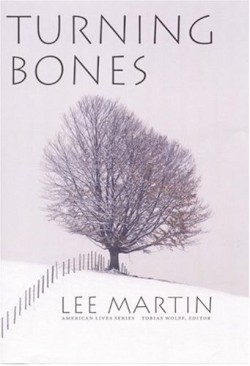Turning Bones
With its roots firmly embedded in the author’s genealogical tree, this story combines fact and fiction in an historical account of one Midwestern farming family across two hundred years and six generations.
Based upon scarce public records that the author was able to recover, the tale begins “somewhere on the Atlantic Ocean, in 1723” with the birth of John Martin, as his parents sail from Ireland to settle in America. The book traces the migration of John Martin’s descendants from Kentucky, Ohio, and Indiana to southern Illinois, where the lineage finally ends with the author himself, now searching for his own place in history.
Martin, an associate professor of English at Ohio State University, is also the author of Quakertown, From Our House, and The Least You Need to Know. The title of his latest work is inspired by the ancient Madagascan tradition of “turning bones,” which involves dancing with the corpses of one’s ancestors.
Alongside the facts that lead the story to present-day Illinois, Martin plots an imagined sentimental journey across generations, showing how love and tragedy repeat themselves over time, from great-grandfather Henry, blind and nearing the end of his life, dreaming of his deceased Mary Ann, and running through cornfields to grandfather William, losing his first wife Elizabeth and being consoled by second wife Eliza, saying, “It’s not for us to know the pain a body carries.”
“We’re all being ruined at the same time,” says Henry. “Getting cured up good, and we know it. That’s how we take to each other.” His comment on how communities are held together by hard living conditions, death, and disease explains why generations of families lived, migrated, intermarried, and worked together.
Martin presents the story as a double-layered narrative incorporating his own life and the imagined lives of his ancestors. He uses his life experience to illustrate the empathy he feels with the characters, and in doing so becomes “the teller exposed in the telling.” The pain of losing a dear friend echoes Will Martin’s grief over losing his wife, and the author’s own marriage is compared with that of Henry Martin and Mary Ann.
The book ends with the aged Henry learning about a cataract operation: “You could see, but it might kill you … what it is to see what you can never have. Such a torment. Such a delight.” The author acknowledges that the truth lies hidden in history and that any attempt at evoking this past will always remain elusive. Dancing with skeletons-the bare bones of facts-is all one can hope for.
Reviewed by
Lara Williams
Disclosure: This article is not an endorsement, but a review. The publisher of this book provided free copies of the book to have their book reviewed by a professional reviewer. No fee was paid by the publisher for this review. Foreword Reviews only recommends books that we love. Foreword Magazine, Inc. is disclosing this in accordance with the Federal Trade Commission’s 16 CFR, Part 255.

